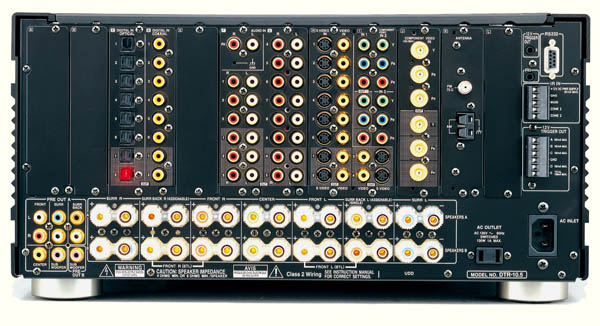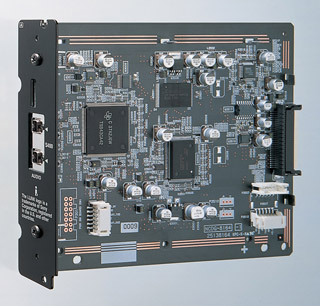|
Very much like the remote, if you decide to change the listening
mode, you push once on the button then spin another to find your selection.
Activating the second zone must also be done by pressing the alternate zone
more than once, at which time the input selection lights up with a second
color. In other words, you may see one color lit on one component for Zone 1
and a second color and component lit for Zone 2. I will tell you this takes
some getting used to, pressing and spinning, pressing and spinning.
The rear of the 10.5 is, well, however you'd like. Iíll explain that statement
next, but let me describe what is standard for the Integra DTR 10.5. There are
color-coded (THX
required) speaker posts arranged along the bottom, two complete sets of
fourteen
posts to be exact. Also there are a full set of pre-outs with two subwoofer connections; one
can be used for speaker B, more on that later as well.
Along with an RS232 port, the DTR 10.5 has an array of 12V triggers, one with
a massive 200 mA current capacity and four with 100 mA. Finally, an RI connection
for other Integra components, a switched AC outlet, and a detachable power cord
complete the normal rear accessories. Every other connection is modular-based
and either standard or optional.

Modules
The removable modules have a vertical design. A single screw removed with a
hex screw at the top and bottom hold them in place. Integra offers seven
optional modules along with the four included modules for the DTR-10.5. What you
do get standard: A module for digital audio, which has eight each optical and
coaxial outputs; A module for analog audio, which includes nine two-channel
inputs and an additional, dedicated phono input; Also on this module are five
outputs, which can be assigned for up to three zones. The third supplied module is
for video: six composite and S-Video input sources (up-converted to 480i), and
four assignable outputs, three High Definition compatible component inputs and
one output. And, lastly, included is an AM/FM tuner module.
 The optional modules of course are the interesting ones. The optional modules of course are the interesting ones.
●
The iLink module is a Firewire connection for digital multi-channel
audio, both DVD-Audio and SACD. One of the benefits of course is
bass management.
●
An HDMI module with two inputs and one output for video.
●
Integration with your computer is handled with a Net-Tune Ethernet module.
Including Internet radio, it gives the ability to access and play back your
computer stored music: mp3, WAV, and WMA files with the aid of a downloadable
music file system Net-Tune Central.
●
For component video, you have a choice of either a BNC or an RCA module, each with
one set of inputs and one set of outputs.
 ● Also a choice is for multi-channel audio inputs: either a module with a pair
of RCA connections, or a module which includes one set of RCA and an AES/EBU
connection. Either will allow bass management through the DTR 10.5 or bypassed
for pure audio. ● Also a choice is for multi-channel audio inputs: either a module with a pair
of RCA connections, or a module which includes one set of RCA and an AES/EBU
connection. Either will allow bass management through the DTR 10.5 or bypassed
for pure audio.
Integra sends along with their lengthy instruction manual a Quick Guide for
those like me who prefer an immediate charge followed by the full set-up
process. Otherwise, use the extensive manual, some common sense and do it
properly.
What you will find as you begin the set-up, are the incredible amount of
options and decisions you must make to take the fullest advantage of the DTR
10.5. Thus Integra sends along accompanying their manual a System Settings
Notebook, which allows you to keep track of all your selections. No less than
10 pages of possible choices can be recorded for future reference. Iím
surprised they donít have a program for your computer to do the same.
 Before you can set up the Integra, obviously the number of zones and the
speaker configuration for each zone must be determined. With fourteen sets of binding posts
on the rear, youíre able to set up two 7.1 channel systems (Main A and Main B). Before you can set up the Integra, obviously the number of zones and the
speaker configuration for each zone must be determined. With fourteen sets of binding posts
on the rear, youíre able to set up two 7.1 channel systems (Main A and Main B).
If youíd prefer to load up one, some speakers in the second would be
sacrificed. For example you may decide to bi-amp a second set of fronts truly
creating that wall of sound while maintaining a 5.1 system in the other.
Much discussion these days of multiple subwoofers and the 10.5 can accommodate
that desire. Of course that removes the sub from the second room. A third
2-channel zone is also possible.
Keeping track of all those speaker cables can be troublesome and for that,
Integra also includes speaker cable color-coded tags or labels.
Click Here to Go to Part III.
Terms and Conditions of Use
|


 The optional modules of course are the interesting ones.
The optional modules of course are the interesting ones.  ● Also a choice is for multi-channel audio inputs: either a module with a pair
of RCA connections, or a module which includes one set of RCA and an AES/EBU
connection. Either will allow bass management through the DTR 10.5 or bypassed
for pure audio.
● Also a choice is for multi-channel audio inputs: either a module with a pair
of RCA connections, or a module which includes one set of RCA and an AES/EBU
connection. Either will allow bass management through the DTR 10.5 or bypassed
for pure audio. Before you can set up the Integra, obviously the number of zones and the
speaker configuration for each zone must be determined. With fourteen sets of binding posts
on the rear, youíre able to set up two 7.1 channel systems (Main A and Main B).
Before you can set up the Integra, obviously the number of zones and the
speaker configuration for each zone must be determined. With fourteen sets of binding posts
on the rear, youíre able to set up two 7.1 channel systems (Main A and Main B).

